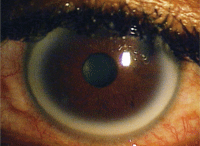 Q: I see patients all the time who have corneal arcus. Should I be sending them to get their cholesterol checked?
Q: I see patients all the time who have corneal arcus. Should I be sending them to get their cholesterol checked?
A: That depends on the patient’s age, says Blair Lonsberry, M.S., O.D., M.Ed., clinic director of Pacific University’s Vision Clinic in Portland, Ore.
“If they’re under 40, I do recommend that they get their cholesterol levels evaluated,” he says.
Corneal arcus (also termed corneal arcus senilis, because it typically occurs in older patients) is caused by lipid deposits that form white, gray or yellow arcs along the peripheral cornea. The arcs may eventually lengthen to form a complete ring around the cornea.
From an ocular standpoint, corneal arcus is a benign, usually age-related condition that doesn’t affect vision. “Most patients will develop it if they live long enough,” Dr. Lonsberry says.
But it does raise concerns in younger (40 and under) patients. Because corneal arcus represents lipid deposits, there’s a chance the patient could have elevated lipid levels, which should prompt you to send these younger patients for cholesterol screening.
Q: So, if the patient has arcus, does that mean he has elevated cholesterol—and is then at risk for coronary heart disease?
A: “Not necessarily, but it’s certainly a possibility we have to consider,” Dr. Lonsberry says.
The connection between corneal arcus and high cholesterol and, therefore, to atherosclerosis has been a tenuous one. And a controversial one, too.
It’s also one with a long history. As far back as 1852, German pathologist Rudolf Virchow hypothesized an association between corneal arcus and atherosclerosis.1

Corneal arcus is an indication of cholesterol. Send younger patients to get their cholesterol checked. Photo: Howell Findley, O.D.
But 40 years later, famed physician William Osler suggested that arcus was not diagnostic for “fatty degeneration” of the heart.2
To this day, the link between corneal lipid deposits and vascular lipid deposits remains controversial. However, in 2008, the National Institutes of Health published an article that concluded: “Corneal arcus reflects widespread tissue lipid deposition and is correlated with both calcific atherosclerosis and xanthomatosis in these patients. Patients with more severe arcus tend to have more severe calcific atherosclerosis. Corneal arcus ... suggests increased atherosclerosis in these hypercholesterolemic patients.”3
Here’s how Dr. Lonsberry explains it to “younger” patients: “There’s a deposit on the front part of your eye that is an indication of cholesterol. I would expect this in a patient over the age of 60, but because you’re younger than that, I would recommend that you have your cholesterol levels checked. It’s not an indication that you absolutely have elevated cholesterol. And even if you do have elevated cholesterol, the deposit in your eye doesn’t indicate if you have the good cholesterol or the bad cholesterol—it’s just an indication of a cholesterol deposit. So my recommendation is that you at least have your cholesterol levels evaluated.”
Meanwhile, send a note to the patient’s primary care physician about the arcus and that you’ve recommended a cholesterol screening.
Also, keep a closer eye on such patients for additional ocular indications of heart disease or other systemic conditions, Dr. Lonsberry says.
1. Virchow R. Ueber perenchymatose Entzundung. In: Archiv für pathologische Anatomie und Physiologie und für klinische Medicin. Volume 4. Berlin; 1852:261-324.
2. Osler W. The principles and practice of medicine: designed for the use of practitioners and students of medicine. New York: D. Appleton and Company; 1892:1079.
3. Zech LA Jr, Hoeg JM. Correlating corneal arcus with atherosclerosis in familial hypercholesterolemia. Lipids Health Dis. 2008 Mar 10;7:7.

